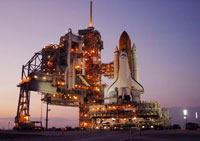Discovery's crew ready to unfurl beam's solar panels
Discovery's crew fixed a solar power tower to the international space station, finishing a moving process, and are ready to unfurl the beam's giant solar panels.

NASA needs to get the tower up and running to prevent malfunctioning station equipment from delaying the addition of a much-anticipated European research lab.
The malfunctioning rotary joint makes sure the huge solar panel wings on the right side of the space station are facing the sun. The gear, which was installed in June, has been experiencing electrical current spikes for nearly two months.
A spacewalking astronaut found black dust resembling metal shavings inside the motorized joint on Sunday.
NASA has limited the joint's motion to prevent the debris from causing permanent damage, but that also limits the system's ability to generate power for the station.
Spacewalker Scott Parazynski spent part of Tuesday inspecting the matching rotary joint that turns the space station's left set of solar wings toward the sun. NASA will examine images he gathered of the perfectly running unit to compare it to the malfunctioning one.
There were no shavings inside the joint, and Parazynski said everything looked pristine.
"It's right out of the shop, no debris whatsoever," he said.
The spacewalkers' main focus, however, was on finishing the grueling task of moving the massive beam to its new home on the far left end of the station. The 17 1/2-ton girder began its 145-foot (44-meter) journey on Sunday.
Parazynski and Douglas Wheelock guided astronauts inside the station as they used a robotic arm to hook up the beam to the orbiting outpost's backbone. The spacewalkers then began installing bolts to hold the beam in place and connecting wires to provide power. They also must remove protective covers from the girder.
"Oh I love this job," Parazynski said as they worked 220 miles (354 kilometers) above southeast Asia. "Beautiful view."
The girder's solar panels are folded up like an accordion and will be unfurled later Tuesday. They will extend 240 feet (73 meters) from tip to tip when outstretched.
Given the problems with the right rotary joint, NASA needs the power generated by the newly installed solar panels to proceed with the planned December launch of the European Space Agency's science lab, named Columbus.
That lab and a Japanese lab set to be delivered early next year will latch onto the new Harmony module that Discovery delivered last week.
The space agency added a day to Discovery's mission so spacewalking astronauts could conduct a detailed inspection of the troublesome joint. That work is scheduled for Thursday.
To make room for that inspection, managers canceled a shuttle thermal tile repair demonstration that was scheduled for that spacewalk. The test was added to the mission after a piece of fuel-tank foam gouged Endeavour's belly on the last shuttle flight in August.
Any repairs to the malfunctioning gear would be put off until after Discovery departs.
Discovery is now scheduled to undock from the space station on Monday and return to Earth on Nov. 7.
Subscribe to Pravda.Ru Telegram channel, Facebook, RSS!


